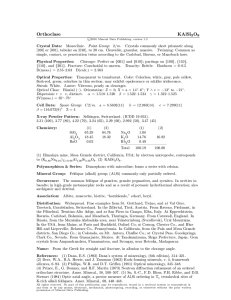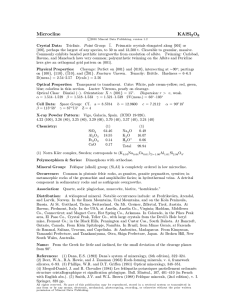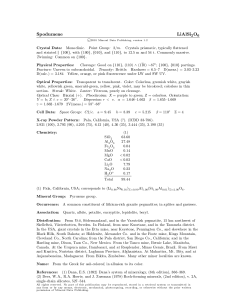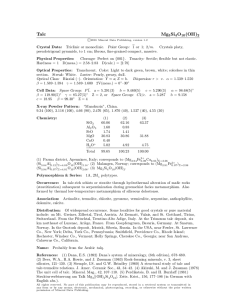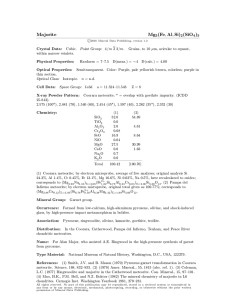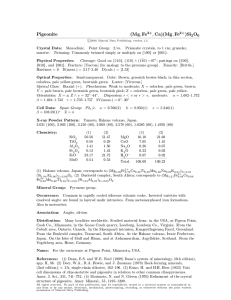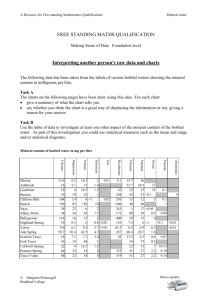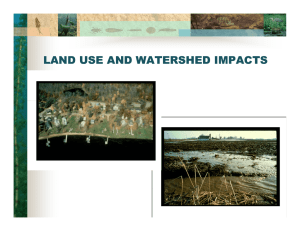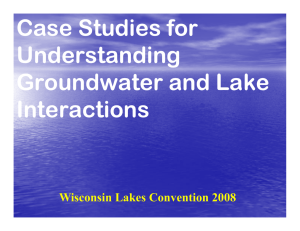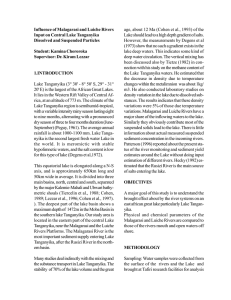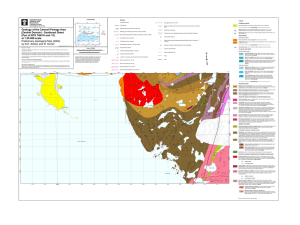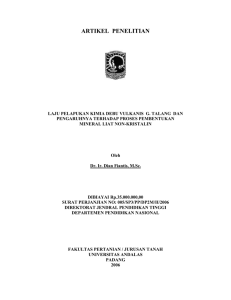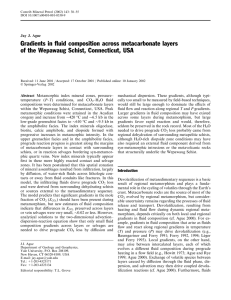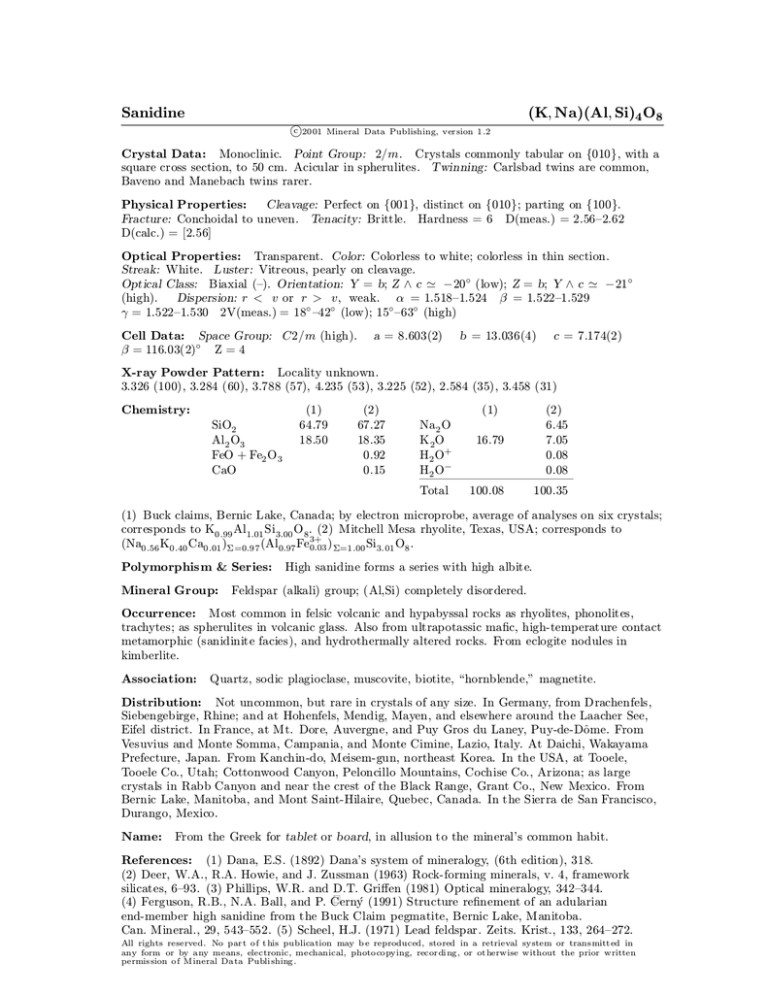
Sanidine
(K; Na)(Al; Si)4 O8
c 2001
°
Mineral Data Publishing, ver sion 1.2
Crystal Data: Monoclinic. Point Group: 2=m: Crystals commonly tabular on f010g, with a
square cross section, to 50 cm. Acicular in spherulites. Twinning: Carlsbad twins are common,
Baveno and Manebach twins rarer.
Physical Properties:
Cleavage: Perfect on f001g, distinct on f010g; parting on f100g.
Fracture: Conchoidal to uneven. Tenacity: Brittle. Hardness = 6 D(meas.) = 2.56{2.62
D(calc.) = [2.56]
Optical Properties: Transparent. Color: Colorless to white; colorless in thin section.
Streak: White. Luster: Vitreous, pearly on cleavage.
Optical Class: Biaxial ({). Orientation: Y = b; Z ^ c ' ¡20 ± (low); Z = b; Y ^ c ' ¡21 ±
(high).
Dispersion: r < v or r > v; weak. ® = 1.518{1.524 ¯ = 1.522{1.529
° = 1.522{1.530 2V(meas.) = 18± {42± (low); 15± {63± (high)
Cell Data: Space Group: C2=m (high).
¯ = 116:03(2)± Z = 4
a = 8.603(2)
b = 13.036(4)
c = 7.174(2)
X-ray Powder Pattern: Locality unknown.
3.326 (100), 3.284 (60), 3.788 (57), 4.235 (53), 3.225 (52), 2.584 (35), 3.458 (31)
Chemistry:
SiO2
Al 2 O3
FeO + Fe2 O 3
CaO
(1)
64.79
18.50
(2)
67.27
18.35
0.92
0.15
(1)
Na 2 O
K 2O
H2 O+
H2 O¡
Total
16.79
(2)
6.45
7.05
0.08
0.08
100.08
100.35
(1) Buck claims, Bernic Lake, Canada; by electron microprobe, average of analyses on six crystals;
corresponds to K0:99 Al 1:01 Si 3:00 O 8: (2) Mitchell Mesa rhyolite, Texas, USA; corresponds to
(Na0:56 K0:40 Ca0:01 )§=0:97 (Al 0:97 Fe3+
0:03 ) §=1:00 Si 3: 01 O8 :
Polymorphism & Series:
Mineral Group:
High sanidine forms a series with high albite.
Feldspar (alkali) group; (Al,Si) completely disordered.
Occurrence: Most common in felsic volcanic and hypabyssal rocks as rhyolites, phonolites,
trachytes; as spherulites in volcanic glass. Also from ultrapotassic ma¯c, high-temperature contact
metamorphic (sanidinite facies), and hydrothermally altered rocks. From eclogite nodules in
kimberlite.
Association:
Quartz, sodic plagioclase, muscovite, biotite, \hornblende," magnetite.
Distribution: Not uncommon, but rare in crystals of any size. In Germany, from Drachenfels,
Siebengebirge, Rhine; and at Hohenfels, Mendig, Mayen, and elsewhere around the Laacher See,
Eifel district. In France, at Mt. Dore, Auvergne, and Puy Gros du Laney, Puy-de-D^o me. From
Vesuvius and Monte Somma, Campania, and Monte Cimine, Lazio, Italy. At Daichi, Wakayama
Prefecture, Japan. From Kanchin-do, Meisem-gun, northeast Korea. In the USA, at Tooele,
Tooele Co., Utah; Cottonwood Canyon, Peloncillo Mountains, Cochise Co., Arizona; as large
crystals in Rabb Canyon and near the crest of the Black Range, Grant Co., New Mexico. From
Bernic Lake, Manitoba, and Mont Saint-Hilaire, Quebec, Canada. In the Sierra de San Francisco,
Durango, Mexico.
Name:
From the Greek for tablet or board, in allusion to the mineral's common habit.
References: (1) Dana, E.S. (1892) Dana's system of mineralogy, (6th edition), 318.
(2) Deer, W.A., R.A. Howie, and J. Zussman (1963) Rock-forming minerals, v. 4, framework
silicates, 6{93. (3) Phillips, W.R. and D.T. Gri®en (1981) Optical mineralogy, 342{344.
·
(4) Ferguson, R.B., N.A. Ball, and P. Cern¶
y (1991) Structure re¯nement of an adularian
end-member high sanidine from the Buck Claim pegmatite, Bernic Lake, Manitoba.
Can. Mineral., 29, 543{552. (5) Scheel, H.J. (1971) Lead feldspar. Zeits. Krist., 133, 264{272.
All rights reserved. No par t of t his publication may b e reproduced, stored in a retrieval system or trans mitt ed in
any form or by any means, electronic, mechanical, photocopying, recor di ng, or ot herwise without the prior written
permis sion of Mineral Data Publi shing.

